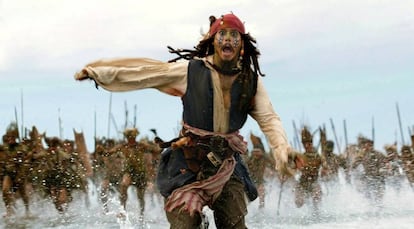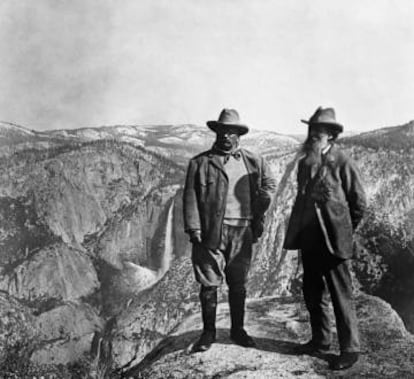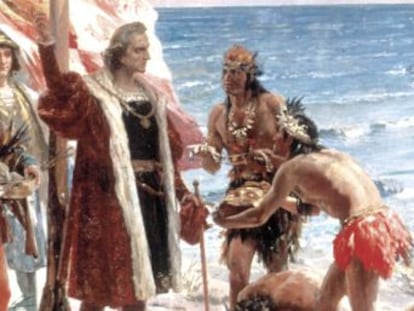Hollywood’s role in spreading the Spanish black legend
A new book explores how movies have emphasized negative aspects of Spain’s imperial past while playing down Anglo-American wrongdoing, often to support a political cause


When he reached the top of the hill, future US president Theodore Roosevelt “shot at the retreating Spaniards, watched one drop to the ground, and though unsure whether it was he who had killed him, boasted, ‘I killed a Spaniard like a rabbit with my own hands’,” Never mind the fact that for 11 hours, 700 Spaniards had resisted an attack by around 15,000 US troops on Kettle Hill, in Cuba, or that they lacked the Gatling guns that their enemy had brought along. Also, Roosevelt showed up when the Buffalo Soldiers – an African-American regiment – had already conquered the hilltop and there was nothing left there but scattered bodies.
Yet in the 1997 US mini-series Rough Riders, and in the 2006 comedy film Night at the Museum, Roosevelt is portrayed as a hero who goes around liberating oppressed peoples. This and other stories about the so-called Spanish “black legend” are included in a book called La imagen de la presencia de España en América (1492-1898) en el cine británico y estadounidense, (or, The image of Spain’s presence in the Americas [1492-1898] in British and US film), published by the Spanish Defense Ministry as part of its Defense Prize Winners collection.
Theodore Roosevelt was awarded a Congressional Medal of Honor that even US military commanders who were his contemporaries felt he did not deserve
Captain Esteban Vicente Boisseau
The author is Captain Esteban Vicente Boisseau, a historian who explored how the black legend that began to circulate in the 16th century has been reflected in modern English-language movies, incorporating anti-Spanish stereotypes for geopolitical reasons.
“No doubt, African Americans would find it unacceptable if Disney theme parks had rides in which Africans were being captured by pirates to the sound of happy music. Yet the message conveyed by Pirates of the Caribbean is that robbing, torturing and killing Spaniards, as well as selling, buying and abusing Hispanic women, and looting, are not only justified, but constitute festive events, a real form of entertainment,” says Boisseau.
The 1992 movie 1492: Conquest of Paradise depicts a somber Castile where heretics are being constantly executed. If the Spanish Inquisition killed 3,000 to 5,000 people over the course of three centuries, according to modern estimates, Henry VIII had more than 50,000 Catholics killed under his reign. One would expect movies set in that era to depict constant executions. But that is not the case.

Years later, Philip II of Spain decided to invade England due to the constant attacks from privateers, to the execution of Mary, Queen of Scots, and the persecution of English Catholics, who had viewed Mary as the legitimate heir to the English throne. He organized a great fleet and in 1588, after a face-off with the English, the Spanish Armada was devastated by a storm. María José Rodríguez Salgado, an emerita professor of international history at the London School of Economics, has said that “no Spanish ship was lost in combat.” But in the 2007 British movie Elizabeth: The Golden Age, Sir Walter Raleigh is shown leading an English ship in flames against the Spanish fleet, causing a giant explosion that ravages numerous enemy ships, even if in reality the Armada sunk several days later due to the storm.
Hollywood movies encourage an image of Anglo colonization of North America that does not reflect its Spanish past. The Spanish presence is depicted as a distant memory that left no mark. In the 1990 movie Dances With Wolves, the main character – a Union Army lieutenant played by Kevin Costner – befriends a Sioux tribe and an elderly man shows him the helmet of a conquistador, saying that those who brought it came during the days of his grandfather’s grandfather, and that in time, these outsiders were kicked out. This gives the impression that there wasn’t a continuous Spanish presence for two centuries in California, Florida, New Mexico and Texas, as in fact there was.
Meanwhile, movies such as the 1969 The Royal Hunt of the Sun belittle the feats performed by Spanish conquistador Francisco Pizarro, who conquered the Inca empire with fewer than 170 men, while Pizarro himself was labeled a traitor for killing Atahualpa, the last Inca emperor. But there is little cinematic exploration of how the British and Anglo-Americans betrayed 389 treaties signed with Indian tribes between 1787 and 1871, using ethnic-cleansing methods.
Tearing down the flag
Two friends, the Americans J. Stuart Blackton and Albert E. Smith, filmed what is considered the first war movie in history, in 1897. It was called Tearing Down the Spanish Flag, and it showed the Spanish flag being taken down and replaced with the American flag over Morro Castle in the port of Havana. It met with great success, as did its 1899 sequel, Raising Old Glory Over Morro Castle. A magazine called The Phonoscope published the following review: "The Spanish flag comes down, and up float the Stars and Stripes. Down comes the symbol of tyranny and oppression that has governed the New World for 400 years, and up goes the flag of freedom."
The movies never do justice to the positive role played by Spanish rulers, who introduced improvements in the Americas and put an end to human sacrifices and cannibalism. The monarchs Elizabeth I, Charles I and Philip II developed a network of hospitals and universities that benefited everyone, Spanish and Native American alike. By contrast, the US government did not grant citizenship to its Indian population until 1924, four centuries later.
Shortly after their arrival in Virginia in 1607, the English settlers committed crimes against the indigenous population. Captain John Smith stood out for his cruelty, yet he is portrayed as a kind, friendly character in the 1995 film Pocahontas. A US professor named Theodore Jojola, who is himself a Native American, said that “the English governor Ratcliffe is transformed [by Hollywood] into a gold-seeking Spanish conquistador.”
Images have long been used for “political ends” to justify the fight against Spain for hegemony in the American continent, says Boisseau. Even before hostilities over Cuba broke out in 1898, movies were made to justify the US invasion. The power of fictional accounts such as Rough Riders is such that, over a century after the Spanish-American war, “that bungling colonel of volunteers and later president of the United States Theodore Roosevelt was awarded a Congressional Medal of Honor that even US military commanders who were his contemporaries felt he did not deserve,” notes Boisseau.
English version by Susana Urra.
Tu suscripción se está usando en otro dispositivo
¿Quieres añadir otro usuario a tu suscripción?
Si continúas leyendo en este dispositivo, no se podrá leer en el otro.
FlechaTu suscripción se está usando en otro dispositivo y solo puedes acceder a EL PAÍS desde un dispositivo a la vez.
Si quieres compartir tu cuenta, cambia tu suscripción a la modalidad Premium, así podrás añadir otro usuario. Cada uno accederá con su propia cuenta de email, lo que os permitirá personalizar vuestra experiencia en EL PAÍS.
¿Tienes una suscripción de empresa? Accede aquí para contratar más cuentas.
En el caso de no saber quién está usando tu cuenta, te recomendamos cambiar tu contraseña aquí.
Si decides continuar compartiendo tu cuenta, este mensaje se mostrará en tu dispositivo y en el de la otra persona que está usando tu cuenta de forma indefinida, afectando a tu experiencia de lectura. Puedes consultar aquí los términos y condiciones de la suscripción digital.
More information
Archived In
Últimas noticias
Most viewed
- Sinaloa Cartel war is taking its toll on Los Chapitos
- Oona Chaplin: ‘I told James Cameron that I was living in a treehouse and starting a permaculture project with a friend’
- Reinhard Genzel, Nobel laureate in physics: ‘One-minute videos will never give you the truth’
- Why the price of coffee has skyrocketed: from Brazilian plantations to specialty coffee houses
- Silver prices are going crazy: This is what’s fueling the rally










































